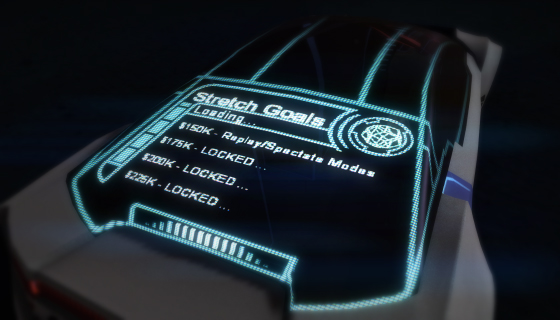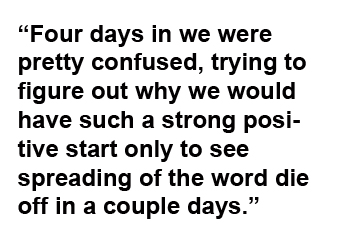By Jordan Hemenway
Editor’s note: As good fortune would have it for Refract Studios, their Kickstarter drive for “Distance” was successfully funded after the writing of this first of two articles covering their campaign. You can jump to Part 2 here.
At this moment there we’re now 3 days and 16 hours away from the end of our Kickstarter campaign for Distance, with about 10 percent to go of our $125,000 goal. It’s been an intense ride, and as I’m sure almost any Kickstarter veteran will say, our mood and feelings are pretty well tied to the increase or decrease of incoming backers coming in at a given moment.

The campaign has been tracking in the red for 2 weeks now, but with a large spike massively helping us in the past three days. One way or another, the campaign will be done at 7 PM on Friday, and at this point it’s hard to say what it’ll feel like to be done with everything. For us right now, it’s hard to see outside of hitting the goal, and being so close is something we weren’t sure was going to happen.
Our success or failure on Friday isn’t just our team’s, it’s the success or failure of a huge community of backers, supporters, and onlookers, and honestly it’s incredible.
Our team at Refract Studios is formed from recent graduates from DigiPen Institute of Technology. We’re three developers who’ve worked on a really wide variety of indie games as student projects, many of which won awards and allowed us to travel around the world to share them. Our final project at DigiPen was called Nitronic Rush, and it was what we called an experimental survival driving game. It was our most popular game with mainstream gamers, getting downloaded over 700,000 times by a surprisingly widespread international audience.
Distance is the game we’re Kickstarting, and it’s a spiritual successor to Nitronic Rush. It’s a complete re-imagining of that game from the ground up.

At the end of the day, Kickstarter is an incredible avenue for indie game devs. Not only does it have the potential to provide you with the funding you need to build your game completely independently, but it challenges you to wrap your head around the marketing of your game, your team, and your vision for the future. You get to connect with an incredibly passionate group of backers that have a piece of the game as their own, as they truly are the difference between the game getting funded or not. Your win on Kickstarter is just as much their win, and your backers are your biggest supporters because they believe in your team to make this project a reality.
Despite a strong start to campaign (hitting 22,000 in the first couple days), the incoming backers very quickly decreased to the point where we weren’t sure if we were going to make it. Four days in we were pretty confused, trying to figure out why we would have such a strong positive start only to see spreading of the word die off in a couple days. The past three weeks have been an astonishing learning curve, and easily one of the most intense learning experiences we’ve probably ever been through. We quickly realized that we had a lot to learn when making the jump from free to commercial products.
One example of this was how we initially pitched the game. From our perspective, Nitronic Rush was a student prototype and Distance would be a professional commercial product, with a much higher bar of quality. It seemed unnecessary to make that clear, but one of our most popular questions was simply asking why they need to pay for a new game after enjoying our free one.
We also realized that we were spending too much time preparing high quality updates and not enough time being human and talking through what was happening with our backers. Honestly, a large part of our assumptions were incorrect going in, but we remained excited and positive throughout since we believed in the project and our backers did as well.
We’ve been fortunate to have industry veterans such as Jon Kimmich, Cliff Bleszinski, Aaron Hightower, Ryan Payton, Christian Allen, among others, involved as influencing forces. We love the game industry not only because it’s an incredible collection of brilliant creative minds, but because it’s filled with generous people. We reached out to each person simply saying what drove us to Kickstarter, which was largely creative control and independence from a publisher. From the darkest of times in the Kickstarter, to the past few days of excitement, we’ve received nothing but positive encouragement and support all along the way from all of them.
Over the next few days we have a few more videos coming, a livestream event happening on Friday counting down the final hours of tears or cheers, and some other fun things that we’ll keep under wraps for a bit longer. We won’t feel content and safe until we hit that goal and the funding is confirmed, so we’ll be pushing for more press and social media outreach for every minute until the end.
To me, Kickstarter is an experience that can’t really be understood until you’ve been through it. I hope that some advice can go a long way if you’re passionate about pursing the process.
Tomorrow, I’ll go a bit more in depth into what we’ve learned and how we might have done things differently could we wind back the clock to the beginning.

